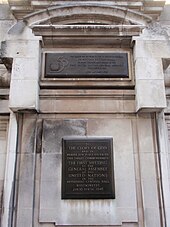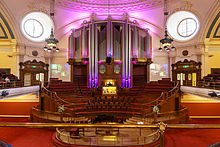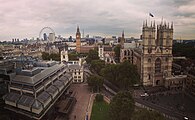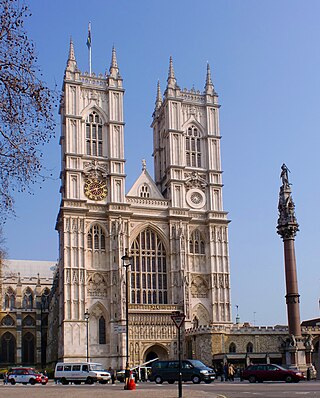
Westminster Abbey, formally titled the Collegiate Church of Saint Peter at Westminster, is an Anglican church in the City of Westminster, London, England. Since 1066, it has been the location of the coronations of 40 English and British monarchs and a burial site for 18 English, Scottish, and British monarchs. At least 16 royal weddings have taken place at the abbey since 1100.

The temperance movement is a social movement promoting temperance or complete abstinence from consumption of alcoholic beverages. Participants in the movement typically criticize alcohol intoxication or promote teetotalism, and its leaders emphasize alcohol's negative effects on people's health, personalities and family lives. Typically the movement promotes alcohol education and it also demands the passage of new laws against the sale of alcohol, either regulations on the availability of alcohol, or the complete prohibition of it.
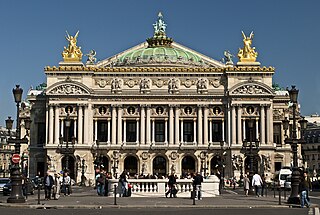
Second Empire architecture is an architectural style rooted in the 16th-century Renaissance, which grew to its greatest popularity in Europe in the second half of the nineteenth century and early years of the twentieth century. As the style evolved from its origins, it acquired a mix of European styles, most notably the Baroque, often combined with mansard roofs and low, square based domes. It derived its name from the Second French Empire of Napoleon III.

The Church House is the home of the headquarters of the Church of England, occupying the south end of Dean's Yard next to Westminster Abbey in London. Besides providing administrative offices for the Church Commissioners, the Archbishops' Council and the Church of England Pensions Board, and a chamber for the General Synod, the building also provided a meeting place for the Parliament of the United Kingdom during World War II, and for some of the organs of the newly formed United Nations afterwards, including the first meeting of the UN Security Council. It has more recently been the venue for several notable public inquiries.

The Coronation Chair, also known as St Edward's Chair or King Edward's Chair, is an ancient wooden chair on which British monarchs sit when they are invested with regalia and crowned at their coronations. It was commissioned in 1296 by King Edward I to contain the Stone of Scone, which he had captured from the Scots. The chair was named after Edward the Confessor and for centuries it was kept in his shrine at Westminster Abbey.
The Methodist Church of Great Britain is a Protestant Christian denomination in Britain, and the mother church to Methodists worldwide. It participates in the World Methodist Council, and the World Council of Churches among other ecumenical associations.

Eucharistic discipline is the term applied to the regulations and practices associated with an individual preparing for the reception of the Eucharist. Different Christian traditions require varying degrees of preparation, which may include a period of fasting, prayer, repentance, and confession.
The Friday fast is a Christian practice of variously abstaining from meat, dairy products and alcohol, on Fridays, or holding a fast on Fridays, that is found most frequently in the Eastern Orthodox, Oriental Orthodox, Catholic, Lutheran, Anglican and Methodist traditions. The Teaching of the Twelve Apostles, written in the first century A.D., directed Christians to fast on both Wednesdays and Fridays. The Wednesday fast is done in remembrance of the story of the betrayal of Christ by Judas on Spy Wednesday, while the Friday fast is done in commemoration of the crucifixion of Jesus Christ on Good Friday. As such, all Fridays of the year have been historically kept in many parts of Christendom as a day of strict fasting and abstinence from alcohol, meat and lacticinia. Abstinence from meat on Fridays is done as a sacrifice by many Christians because they believe that on Good Friday, Jesus sacrificed his flesh for humanity. In the Eastern Orthodox Church, in addition to fasting from food until sundown, the faithful are enjoined to abstain from sexual relations on Fridays as well.
The West London Methodist Mission was established in 1887 under the leadership of Hugh Price Hughes, a leading voice in Methodism and in Non-Conformity, and has a long track record as a Methodist ministry and as a spiritual home for "good works". Its early days are very much associated with its founder, Price Hughes, a strong supporter of Britain's temperance movement. The mission has been instrumental in teaching Methodism, and providing a spiritual and physical base from which such notable Methodists as Lord Soper worked. At its founding it was associated with suffragettes and suffragists, and gave them encouragement and active assistance.
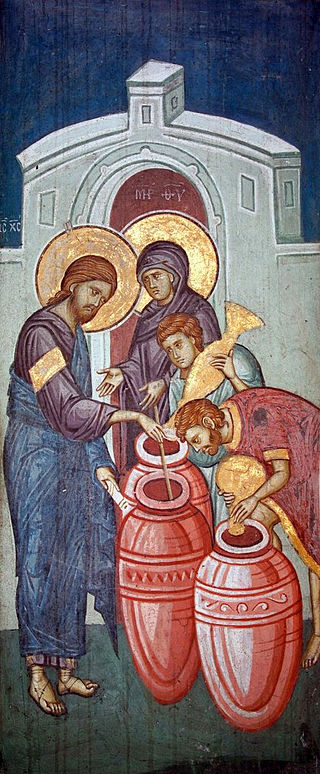
Christian views on alcohol are varied. Throughout the first 1,800 years of Church history, Christians generally consumed alcoholic beverages as a common part of everyday life and used "the fruit of the vine" in their central rite—the Eucharist or Lord's Supper. They held that both the Bible and Christian tradition taught that alcohol is a gift from God that makes life more joyous, but that over-indulgence leading to drunkenness is sinful. However, the alcoholic content of ancient alcoholic beverages was significantly lower than that of modern alcoholic beverages. The low alcoholic content was due to the limitations of fermentation and the nonexistence of distillation methods in the ancient world. Rabbinic teachers wrote acceptance criteria on consumability of ancient alcoholic beverages after significant dilution with water, and prohibited undiluted wine.
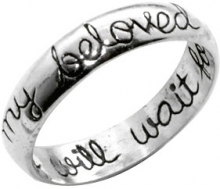
Abstinence is the practice of self-enforced restraint from indulging in bodily activities that are widely experienced as giving pleasure. Most frequently, the term refers to sexual abstinence, but it can also mean abstinence from alcohol, drugs, food, or other comforts.

Sir Robert William Perks, 1st Baronet was a British Liberal politician.
The Wesleyan Methodist Church was the majority Methodist movement in England following its split from the Church of England after the death of John Wesley and the appearance of parallel Methodist movements.

Albert Basil Orme Wilberforce was an Anglican priest and author in the second half of the 19th century and the first two decades of the 20th. He was the Chaplain to the Speaker of the House of Commons and Archdeacon of Westminster.

Caxton Hall is a building on the corner of Caxton Street and Palmer Street, in Westminster, London, England. It is a Grade II listed building primarily noted for its historical associations. It hosted many mainstream and fringe political and artistic events and after the Second World War was the most popular register office used by high society and celebrities who required a civil marriage.
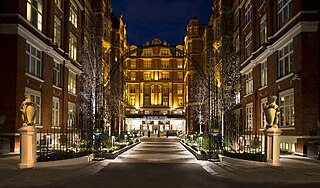
St. Ermin's Hotel is a four-star central London hotel adjacent to St James's Park Underground station, close to Westminster Abbey, Buckingham Palace, and the Houses of Parliament. The Grade II-listed late Victorian building, built as one of the early mansion blocks in the English capital, is thought to be named after an ancient monastery reputed to have occupied the site pre-10th century. Converted to a hotel in 1896–1899, it became during the 1930s, through the Second World War and beyond, a meeting place of the British intelligence services, notably the birthplace of the Special Operations Executive (SOE), and where notorious Cambridge Five double agents Philby and MacLean met their Russian handlers. St Ermin's is now part of Marriott Hotels' Autograph Collection. The hotel is owned by the family of Tei-Fu Chen, founder of Sunrider International.
The temperance movement in the United Kingdom was a social movement that campaigned against the recreational use and sale of alcohol, and promoted total abstinence (teetotalism). In the 19th century, high levels of alcohol consumption and drunkenness were seen by social reformers as a danger to society's wellbeing, leading to social issues such as poverty, child neglect, immorality and economic decline. Temperance societies began to be formed in the 1830s to campaign against alcohol. Specific groups were created over periods of time dedicated to the different aspects of drinking. For example, in 1847, the Band of Hope was created to persuade children not to start drinking alcohol. Most of these temperance groups were aimed at the working class. Temperance was also supported by some religious groups, particularly the Nonconformist Churches. Although the temperance movement met with local success in parts of Britain, it failed to impose national prohibition, and disappeared as a significant force following the Second World War.

Teetotalism is the practice or promotion of total personal abstinence from the consumption of alcohol, specifically in alcoholic drinks. A person who practices teetotalism is called a teetotaler or teetotaller, or is simply said to be teetotal. Globally, almost half of adults do not drink alcohol. A number of temperance organisations have been founded in order to promote teetotalism and provide spaces for non-drinkers to socialise.


